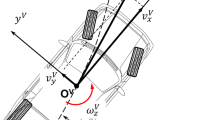Abstract
A linearization method and an engineering approach for the geometric nonlinear aeroelastic stability analysis of the very flexible aircraft with high-aspect-ratio wings are established based on the little dynamic perturbation assumption. The engineering practicability of the method is validated by a complex example. For a high-altitude long-endurance unmanned aircraft, the nonlinear static deformations under straight flight and the gust loads are calculated. At the corresponding nonlinear equilibrium state, the complete aircraft is linearized dynamically and the vibration modes are calculated considering the large deformation effects. Then the unsteady aerodynamics are calculated by the double lattice method. Finally, the aeroelastic stability of the complete aircraft is analyzed. The results are compared with the traditional linear calculation. The work shows that the geometric nonlinearity induced by the large structural deformation leads to the motion coupling of the wing chordwise bending and the torsion, which changes the mode frequencies and mode shapes. This factors change the aeroelastic coupling relationship of the flexible modes leading to the decrease of the flutter speed. The traditional linear method would give not only an imprecise flutter speed but also a possible dramatic mistake on the stability. Hence, for a high-altitude long-endurance unmanned aircraft with high-aspect-ratio wings, or a similar very flexible aircraft, the geometric nonlinear aeroelastic analysis should be a necessary job in engineering practice.
Similar content being viewed by others
References
van Schoor M C, von Flotow A H. Aeroelastic characteristics of a highly flexible aircraft. J Aircraft, 1990, 27: 901–908
Patil M J. Nonlinear Aeroelastic Analysis, Flight Dynamics, and Control of a Complete Aircraft. Dissertation of Doctoral Degree. Atlanta: Georgia Institute of Technology, 1999
Patil M J, Hodges D H. Nonlinear aeroelasticity and flight dynamics of high-altitude long-endurance aircraft. J Aircraft, 2001, 38: 88–94
Dowell E, Edwards J, Strganac T. Nonlinear aeroelasticity. J Aircraft, 2003, 40: 857–874
Patil M J, Hodges D H. On the importance of aerodynamic and structural nonlinearities in aeroelastic behavior of high-aspect-ratio wings. In: 41st AIAA/ASME/ASCE/AHS/ASC Structures, Structural Dynamics, and Materials Conference and Exhibit, Atlanta, 2000. AIAA-2000-1448
Tang D, Dowell E H. Experimental and theoretical study on aeroelastic response of high-aspect-ratio wings. AIAA J, 2001, 39: 1430–1441
Xie C C. Statics/Dynamics Coupling Theory and Test Study of Aircraft Aeroelastic Stability. Dissertation of Doctoral Degree. Beijing: Beijing University of Aeronautics and Astronautics, 2009
Zh J. Modeling and Simulation of Coupled Nonlinear Aeroelasticity and Flight Dynamics for Flexible Aircraft. Dissertation of Doctoral Degree. Beijing: Beijing University of Aeronautics and Astronautics, 2010
Cesnik C E S, Su W H. Nonlinear aeroelastic modeling and analysis of fully flexible aircraft. In: 46th AIAA/ASME/ASCE/AHS/ASC Structures, Structural Dynamics, and Materials Conference, Austin, 2005. AIAA2005-2169
Chang C, Hodges D H, Patil M J. Flight dynamics of highly flexible aircraft. J Aircraft, 2008, 45: 538–545
Shearer C M, Cesnik C E S. Nonllinear flight dynamics of very flexible aircraft. J Aircraft. 2007, 44: 1528–1545
Strong D D, Kolonay R M, Huttsell L J, et al, Flutter analysis of wing configurations using pre-stressed frequencies and mode shapes. In: 46th AIAA/ASME/ASCE/AHS/ASC Structures, Structural Dynamics, and Materials Conference, Austin, 2005. AIAA 2005-2173
Xie C C, Wu Z G, Yang C. Aeroelastic analysis of flexible large aspect ratio wing. J Beijing Univ Aero Astro, 2003, 29: 1087–1090
Xie C C, Leng J Z, Yang C. Geometrical nonlinear aeroelastic stability analysis of a composite high-aspect-ratio wing. Shock Vib, 2008, 15: 325–333
Leng J Z, Xie C C, Yang C. Influence of chordwise bending stiffness on aeroelastic characteristics of flexible high aspect ratio wing. J Beijing Univ Aero Astro, 2009, 35: 718–722
Rodden W P, Johnson, E H. MSC/NASTRAN Version 68 Aeroelastic Analysis Users Guide. New York: The MacNeal-Schwendler Corporation, 1994
Wang X C, Shao M. Theory and Numerical Methods of Finite Element Method(in Chinese). Beijing: Tsinghua University Press, 1997
Guan De. Unsteady Aerodynamics Calculation (in Chinese). Beijing: Beijing University Aeronautics and Astronautics Press, 1991
Shirk M H, Hertz T J, Weisshaar T A. Aeroelastic tailoring—theory, practice, and promise. J Aircraft, 1986, 23: 6–18
Author information
Authors and Affiliations
Corresponding author
Rights and permissions
About this article
Cite this article
Xie, C., Yang, C. Linearization method of nonlinear aeroelastic stability for complete aircraft with high-aspect-ratio wings. Sci. China Technol. Sci. 54, 403–411 (2011). https://doi.org/10.1007/s11431-010-4252-5
Received:
Accepted:
Published:
Issue Date:
DOI: https://doi.org/10.1007/s11431-010-4252-5




